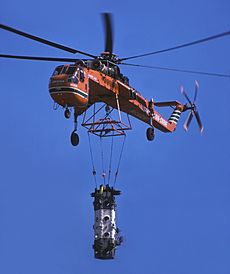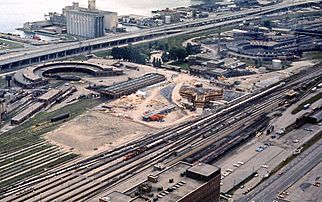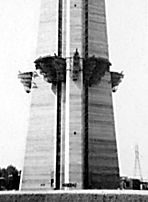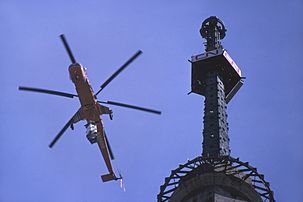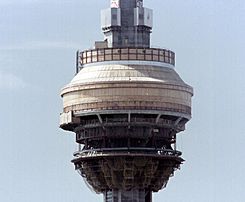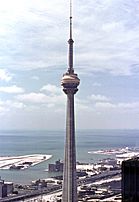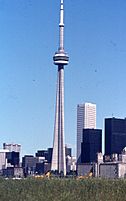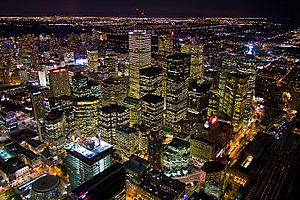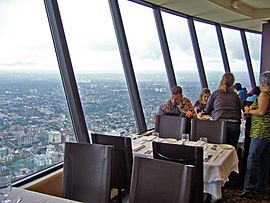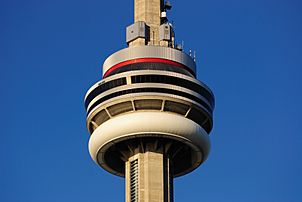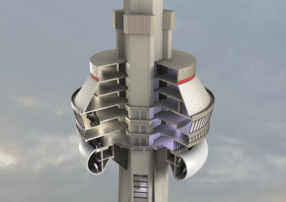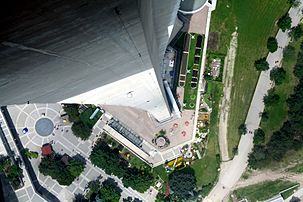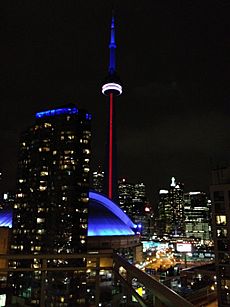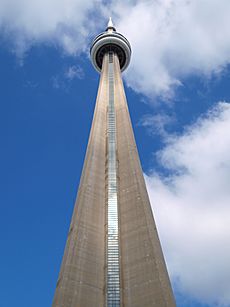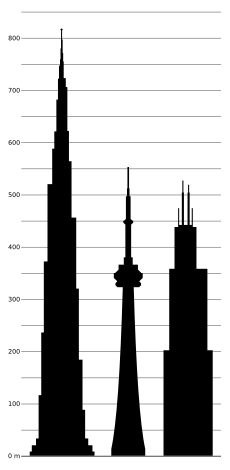CN Tower facts for kids
Quick facts for kids CN Tower |
|
|---|---|
|
Tour CN
|
|

The CN Tower is the world's 9th tallest free-standing structure
|
|
| Alternative names | Canadian National Tower, Canada's National Tower |
| Record height | |
| Tallest in the world from 1975 to 2007 | |
| Preceded by | Ostankino Tower |
| Surpassed by | Burj Khalifa |
| General information | |
| Status | Complete |
| Type | Mixed use: Observation, telecommunications, attraction, restaurant |
| Address | 290 Bremner Boulevard Toronto, Ontario M5V 3L9 |
| Coordinates | 43°38′33.36″N 79°23′13.56″W / 43.6426000°N 79.3871000°W |
| Construction started | 1973 |
| Completed | 1976 |
| Opening | June 26, 1976 |
| Cost | CA$63,000,000 |
| Owner | Canada Lands Company |
| Height | |
| Antenna spire | 553.3 m (1,815.3 ft) |
| Roof | 457.2 m (1,500.0 ft) |
| Top floor | 446.5 m (1,464.9 ft) |
| Technical details | |
| Floor count | Equivalent of a 147-storey building |
| Lifts/elevators | 9 |
| Design and construction | |
| Architect | WZMH Architects: John Andrews, Webb Zerafa, Menkes Housden |
The CN Tower (which means "Tour CN" in French) is a huge concrete tower in Toronto, Ontario, Canada. It stands 553.3 m-high (1,815.3 ft)! It was built for communications and observation.
The tower was finished in 1976. Its name "CN" first stood for Canadian National, the railway company that built it. Later, the railway company sold the tower to the Canada Lands Company, a government company that handles real estate.
For 32 years, the CN Tower was the tallest free-standing structure in the world. This means it stood on its own without wires or other supports. In 2007, the Burj Khalifa became taller. The CN Tower was also the tallest tower in the world until 2009, when the Canton Tower surpassed it.
Today, the CN Tower is the ninth tallest free-standing structure in the world. It is still the tallest free-standing structure on land in the Western Hemisphere (North and South America). In 1995, the American Society of Civil Engineers called the CN Tower one of the modern Seven Wonders of the World. It is also part of the World Federation of Great Towers.
The CN Tower is a famous symbol of Toronto's skyline. More than two million people from around the world visit it every year!
Contents
History of the CN Tower
The idea for the CN Tower started in 1968. The Canadian National Railway wanted to build a tall platform for TV and radio signals in Toronto. They also wanted to show how strong Canadian industry was. These plans became official in 1972.
Toronto was growing fast in the late 1960s and early 1970s. Many tall buildings, called skyscrapers, were built downtown. These shiny new buildings made it hard for TV and radio signals to travel. New, taller antennas were needed, at least 300 m (980 ft) high. The CN Tower was designed to solve this problem.
The first plan for the tower looked like a tripod with three separate pillars. But as the design changed, it became the single, hexagonal shape we see today. The idea for the main observation deck came later. An engineer thought visitors would pay extra for a higher view. It was also realized that the tower could become the world's tallest structure, so plans were adjusted to make it happen.
Building the Tower
Construction of the CN Tower began on February 6, 1973. Workers dug a huge hole for the foundation. They removed 56,000 t (62,000 short tons; 55,000 long tons) of earth and shale. The foundation used 7,000 m3 (9,200 cu yd) of concrete and lots of steel. This part of the building process was very fast, taking only four months.
To build the main support pillar, workers used a special method called "slipforming." A large metal platform slowly raised itself using jacks, moving up about 6 m (20 ft) each day as the concrete dried. Concrete was poured five days a week. By February 22, 1974, the tower was already the tallest structure in Canada.
The tower used 40,500 m3 (53,000 cu yd) of concrete, all mixed right there. This made sure the concrete was always the same quality. Workers used special tools to make sure the tower was built straight up. It is only off from being perfectly straight by about 29 mm (1.1 in)!
In August 1974, work started on the main observation level. Giant steel and wooden forms were slowly lifted into place using hydraulic jacks. These forms helped create the supports for the main level. The SkyPod (the highest observation deck) was also built with concrete and steel.
The CN Tower officially became the world's tallest free-standing structure on March 31, 1975, even though it was still being built.
The antenna was supposed to be lifted by a crane. But then, a special helicopter called "Olga" became available. Olga was used to remove the crane first. Then, it flew the antenna up in 36 separate pieces! This saved months of construction time. The helicopter work took only three and a half weeks instead of six months. The tower was "topped-off" on April 2, 1975, after 26 months of building. It officially took the height record from Moscow's Ostankino Tower.
Building Progress
Opening and Early Years
The CN Tower opened to the public on June 26, 1976. It cost about CA$63 million to build, but this money was paid back in 15 years.
When it first opened, the CN Tower had three public viewing areas. The SkyPod was the highest at 447 m (1,467 ft). The Indoor Lookout Level was at 346 m (1,135 ft), and the Outdoor Observation Terrace was at 342 m (1,122 ft). There was also a restaurant called the Top of Toronto Restaurant, which slowly spun around once every 72 minutes.
In 1994, a cool glass floor was added at 342 m (1,122 ft). You can stand on it and look straight down! In 1995, the Canadian National Railway sold the tower to Canada Lands Company. The tower's name stayed the same, but it was sometimes called Canada's National Tower.
In 2007, the old light bulbs that lit up the tower at night were replaced with new, energy-saving LED lights. These new lights can change colors, making the tower look different for special events. On September 12, 2007, the Burj Khalifa in Dubai became the world's tallest free-standing structure, passing the CN Tower. In 2008, glass panels were added to one of the CN Tower's elevators. This made it the highest glass-floored elevator in the world!
EdgeWalk and Special Events
On August 1, 2011, the CN Tower opened the EdgeWalk. This is an exciting activity where brave visitors can walk around the outside roof of the main pod, 356 m (1,168.0 ft) high! You are safely attached to an overhead rail system. It is the world's highest full-circle, hands-free walk. The EdgeWalk closes in winter and during bad weather.
The CN Tower has been part of many special events.
Pan Am Games
In 2015, the CN Tower was a big part of the opening ceremony for the Pan Am Games. A video showed Canadian athletes Bruny Surin and Donovan Bailey on the EdgeWalk. Then, a fireworks show from the tower ended the ceremony.
Canada 150
On July 1, 2017, for Canada's 150th birthday, fireworks were launched from the tower again. The show was five minutes long and matched the tower lights and music on a local radio station.
Closures
The CN Tower has closed a few times for safety reasons.
- It was closed during the G20 summit on June 26–27, 2010, because of security concerns.
- The CN Tower has been closed since 2020 due to COVID-19 pandemic rules in Ontario.
How the Tower is Built
The CN Tower has several parts. The main part is a hollow concrete pillar shaped like a hexagon. Inside are the stairwells and connections for power and water. The tower has six elevators. They are located in three sections that stick out from the hexagon, with two elevators in each section. These elevators have glass windows, so you can see the city as you go up!
On top of the concrete part is a 102-metre (334.6 ft) tall metal antenna. This antenna sends out TV and radio signals.
There are three main visitor areas:
- The Glass Floor and Outdoor Observation Terrace are at 342 metres (1,122 ft).
- The Indoor Lookout Level is at 346 metres (1,135 ft).
- The SkyPod is much higher, at 446.5 metres (1,465 ft), just below the metal antenna.
The main deck level has seven floors, and some are open to the public. Below the public areas, at 338 m (1,108.9 ft), is a large white donut-shaped area called a radome. This holds the tower's UHF transmitters.
The glass floor is 24 m2 (258 sq ft) big and is very strong. It can hold a lot of weight. The glass is 64 mm (2.5 in) thick. In 2008, one elevator was updated to have a glass floor panel. The Horizons Cafe and the lookout level are at 346 metres (1,135.2 ft). The 360 Restaurant, which spins around, is at 351 m (1,151.6 ft). It takes 72 minutes for the restaurant to make one full turn.
The SkyPod used to be the highest public observation deck in the world. But in 2008, the Shanghai World Financial Center became higher.
A metal staircase goes up to the main deck level with 1,776 steps. To reach the SkyPod, you need to climb 2,579 steps in total. This is the tallest metal staircase on Earth! These stairs are usually only for emergencies. However, twice a year, people can climb them for charity events. The fastest climb on record was 7 minutes and 52 seconds in 1989.
Architects
The CN Tower was designed by several architects:
- WZMH Architects
- John Hamilton Andrews
- Webb Zerafa
- Menkes Housden with the help of E.R. Baldwin
Falling Ice Danger
Sometimes, ice can form on the tower during freezing rain. When the sun melts the ice and strong winds blow, pieces of ice can fall off. On March 2, 2007, police had to close streets around the tower because of falling ice. The Gardiner Expressway, a major highway, was also closed.
On April 16, 2018, falling ice from the CN Tower even made a hole in the roof of the nearby Rogers Centre stadium! This caused a baseball game to be postponed. The CN Tower reopened a few days later.
Safety Features
After a fire at the Ostankino Tower in Moscow in 2000, people wondered if the CN Tower was safe. However, Canadian officials said it is "highly unlikely" a similar fire could happen at the CN Tower. It has many important safety features:
- The tower is built with fireproof materials.
- It has frequent and strict safety checks.
- There is a large sprinkler system.
- A 24-hour emergency team monitors the tower.
- Two large water tanks at the top automatically refill.
- A powerful fire hose at the bottom can send lots of water to any part of the tower.
- Natural gas appliances are not allowed in the tower.
- An elevator on the outside of the building can be used during a fire. It has its own emergency power.
The CN Tower has a great safety record. There was a small electrical fire in the antenna on August 16, 2017, but it was the tower's first fire.
Lighting
The CN Tower used to be lit with old-fashioned light bulbs. In 2007, these were replaced with 1,330 super-bright LED lights. These lights are inside the elevator shafts and shine up the tower's mast. They light up the tower from dusk until 2 a.m. The new LEDs use much less energy than the old lights.
The tower changes its lighting colors for holidays and important events. For example, after the 95th Grey Cup in Toronto, it was lit in green and white for the winning team. When important people like Jack Layton or Nelson Mandela passed away, the tower was lit in special colors to remember them. On the night of the attacks in Paris on November 13, 2015, the tower showed the colors of the French flag.
The lights are controlled by a computer in Burlington, Ontario. They cost about $1,000 per month to run.
During spring and autumn, when birds are migrating, the lights are turned off. This helps protect birds from flying into the tower.
| Date | Colour | Occasion |
|---|---|---|
| Ongoing | Red and White | Top of the hour CN Tower light show |
| January 26 | Light Blue and Yellow | World Alzheimer Day |
| February 4 | Orange and Blue | World Cancer Day |
| February 14 | Red | Valentine's Day |
| March 17 | Green | Saint Patrick's Day |
| March 21–June 20 | Decreased Lighting | Bird Migration - Lighting is decreased during spring bird migration |
| September 23–December 20 | Decreased Lighting | Bird Migration - Lighting is decreased during autumn bird migration |
| December | Red and Green | Season's Greetings |
| December 1 | Red | World AIDS Day |
| December 6 | Purple | White Ribbon Day |
| December 10 | Yellow | Human Rights Day |
| December 21 | Blue and White | First Day of Winter |
| December 31 | Countdown to 2026 and Light Show | New Year's Eve |
Height Comparisons

The CN Tower is the tallest free-standing structure in the Western Hemisphere. As of 2013, only two other free-standing structures in the Western Hemisphere are taller than 500 m (1,640.4 ft). These are the Willis Tower in Chicago (527 m (1,729.0 ft)) and the One World Trade Center in New York City (541.33 m (1,776.0 ft)). The One World Trade Center is about 12 m (39.4 ft) shorter than the CN Tower.
"World's Tallest Tower" Title
Guinness World Records has called the CN Tower "the world's tallest self-supporting tower" and "the world's tallest free-standing tower."
Organizations like Emporis and the Council on Tall Buildings and Urban Habitat say the CN Tower is not a "true building." They define a building as a structure with floors all the way from the ground up, used for living, business, or making things. The CN Tower has observation decks and restaurants, but not floors all the way up. So, they call it a "tower."
The CN Tower was the tallest tower by this definition until 2010. Then, the Canton Tower in China became taller at 604 metres (1,982 ft). In 2011, the Tokyo Sky Tree became the tallest tower at 634.0 metres (2,080.1 ft).
On September 12, 2007, the Burj Khalifa in Dubai became the world's tallest free-standing structure, passing the CN Tower. The Burj Khalifa is a hotel, residential, and commercial building.
Even after the Burj Khalifa became the tallest free-standing structure, Guinness World Records still recognized the CN Tower as the world's tallest free-standing tower. This is because the Burj Khalifa has too many usable floors to be called a tower. The CN Tower also held records for the highest wine cellar (in the 360 Restaurant) at 351 metres (1,152 ft), the highest restaurant at 346 metres (1,135 ft) (Horizons Restaurant), and the tallest free-standing concrete tower.
As of 2018, the CN Tower is the ninth-tallest free-standing structure on land. It is still the tallest free-standing structure in the Western Hemisphere. It is also the third-tallest tower in the world.
Height Records
Since it was built, the CN Tower has held these world height records:
| Record | Owner | Value | Time period | Succeeded by |
|---|---|---|---|---|
| World's tallest free-standing structure | CN Tower | 553.33 metres (1,815.4 ft) | March 31, 1975 to September 12, 2007 | Burj Khalifa |
| World's tallest tower | CN Tower | 553.33 metres (1,815.4 ft) | 1975 to 2009 | Canton Tower |
| World's highest public observation gallery | SkyPod | 447 metres (1,467 ft) | ||
| World's highest glass floor panelled elevator | CN Tower | 346 metres (1,135 ft) | 2008 to present | — |
| World's longest metal staircase | CN Tower | 2,579 steps | ||
| World's highest glass floor | CN Tower | 342 metres (1,122 ft) | 2008 to July 2, 2009 | Willis Tower |
| World's highest and largest revolving restaurant | 360 Restaurant | 351 metres (1,152 ft) | ||
| World's highest bar | Horizons Restaurant | 346 metres (1,135 ft) | September 21, 2009 to present | — |
| World's highest wine cellar | 360 Restaurant | 351 metres (1,152 ft) |
What the Tower is Used For
The CN Tower is used as a communications tower. It sends out TV and radio signals for many different companies. It is also a very popular tourist attraction.
In Popular Culture
The CN Tower has appeared in many movies, TV shows, music album covers, and video games. The tower even has its own official mascot, which looks just like the tower!
- Highpoint is a 1982 Canadian action movie. It shows stuntman Dar Robinson jumping off the CN Tower in 1979.
- Views is a 2016 album by Canadian rapper Drake. The album cover shows Drake sitting on top of the CN Tower. The CN Tower's Twitter account later confirmed that the image was photo edited.
See also
 In Spanish: CN Tower para niños
In Spanish: CN Tower para niños




